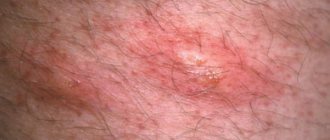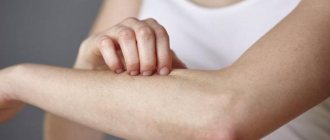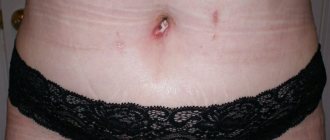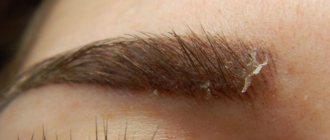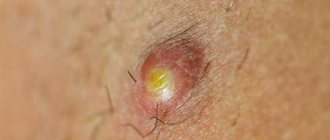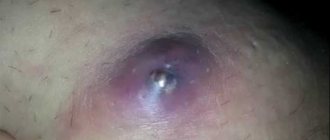The formation of papules or pimples in the genital area can be a short-term phenomenon. Or a sign of a serious infectious disease.
More often, the development of acne in the perineum is observed in women. Because their skin is thinner and has increased sensitivity to various irritating factors. The danger of rashes can be judged only after diagnosis and identification of the true cause of the symptom.
Differential diagnosis of rashes mainly lies in their differences. It is necessary to establish the nature of acne: infectious inflammatory papules, non-infectious inflammatory or neoplastic papules with an atypical process. Infectious inflammatory papules are the result of a viral, bacterial, or fungal infection. May cause spirochetes or parasites to enter the body.
Non-infectious rashes are more often allergic in nature. They can also be a papular skin disease. They develop against the background of a neurological, physical factor, or may be the result of a malfunction of the sebaceous glands.
Acne and other types of rashes in the genital area
Pimples in the perineum, depending on the cause of development, may have a different structure, color, and size. When examining a patient, it is important to take into account all these parameters. The diagnosis is made only after a thorough diagnostic examination.
In clinical practice, the following types of rashes are distinguished:
- White-pink papules, dense to the touch. Such rashes are not a consequence of a pathological process - an accumulation of dead cells of the outer layer of the skin. You can fix the problem by taking a shower using a rough washcloth.
- Pinkish , dense to the touch and densely concentrated pimples. Appear due to blockage of the sebaceous glands. Depending on the severity of the clinic, local treatment with the use of balsamic liniment (Vishnevsky ointment) may be necessary.
- Bright pink , red, very small or with a secretion inside, they can be located throughout the body. They manifest themselves as an allergic reaction to food and chemicals. Visually, such rashes are similar to pimples in the perineum during diaper rash. You can eliminate the signs of an allergic reaction by taking a single antihistamine: Cetrin, Cetirizine, Tavegil
- Red or dark red , dry, with a crust on the surface. Similar pimples in the perineum of women or men develop during an inflammatory lesion of the skin - dermatitis, which belongs to the group of allergic dermatoses. Treatment involves eliminating the provoking factor, using local antipruritic ointments/creams, and taking antihistamines.
- Pink or intensely red , small, localized. Such rashes, including in the perineal area, develop as a result of incorrect, mechanical impact on the skin, for example, after shaving or intense friction. As a treatment, it is recommended to use soothing ointments (Panthenol, Aloe gel)
These are the most harmless types of rashes that do not pose a danger to humans.
However, the development of such symptoms may indicate an ongoing infectious process. It may require urgent treatment. So, acne in the perineum can appear due to genital infections or serious hormonal imbalance.
How to treat a boil on the labia, pubic part of the body, in the groin in women and men?
A painful lump in the genital area and on the skin of the groin may well be a boil - an inflammatory process in the hair follicle. Such a neoplasm requires close attention and adequate timely treatment.
Why do abscesses appear in the groin?
A furuncle or boil is an extremely painful growth that fills with pus. Its occurrence is associated with the activity of pathogenic bacteria, usually Staphylococcus aureus. This microorganism can be found on the skin of absolutely healthy people and not cause any problems. However, in the presence of certain predisposing factors, bacteria penetrate to the hair root and become the cause of a pronounced inflammatory process, which also affects the sebaceous gland. The appearance of boils in the groin can be caused by:
- Increased sweating.
- Microtraumas of the skin, including during shaving, etc.
Wearing tight and/or synthetic underwear.
According to medical statistics, boils most often occur in patients with a certain predisposition. The risk of such neoplasms is especially high in:
- People with reduced immunity.
- Patients taking medications that suppress immune activity.
- People leading an unhealthy lifestyle. This applies to both nutrition and bad habits.
- People who do not follow the rules of personal hygiene.
- Patients with skin diseases that are accompanied by violations of the integrity of the epidermis.
- Obese people.
Boils can occur in different parts of the groin area. Most often, abscesses appear in the perineum, on the skin of the labia, and also at the anus. Sometimes ulcers are found on the pubic area or on the scrotum. There is a risk of painful boils appearing on the body of the penis.
It is worth considering that a boil in the groin may be the first sign of some serious health problems that cause a decrease in immunity. Therefore, with such a disease, it is better not to self-medicate, but to seek medical help.
Small pustules on the pubic area
As a rule, the appearance of small pustules on the skin of the pubic area is associated with insufficient hygiene or improper hair removal.
Such pimples should not be identified with boils; they are superficial and indicate the development of folliculitis.
Fortunately, this disease is somewhat easier to treat than boils, and causes much less discomfort to the sick person. However, the lack of proper therapy can lead to extremely unpleasant consequences, for example, the spread of an infectious process.
On female intimate organs
Women are much more likely than men to resort to mechanical hair removal in the groin area, so their risk of developing boils in such places is slightly higher. Painful bumps most often occur at the border of underwear - in places of maximum pressure. An abscess may also appear at the site of an injury received while shaving.
An abscess can form on the labia majora, but classic boils on the labia minora simply do not happen, since there are no hair follicles in this place. In such a place, simple pimples with a purulent head may appear; they can also cause quite noticeable discomfort and pain. But they are not as dangerous as boils.
Boil in the vagina
There is also no hair and, accordingly, hair follicles in and around the vagina. So boils cannot form in such an area.
However, many women, faced with a painful lump-shaped lump near the entrance to the vagina, immediately assume the development of a boil. In fact, such a neoplasm is most often a symptom of inflammation of the Bartholin gland - bartholinitis.
This disease is also bacterial in nature and can develop against the background of decreased immunity, as well as various sexually transmitted and infectious diseases.
The appearance of signs of bartholinitis is a reason to quickly seek help from a gynecologist. Most often, this disease responds successfully to conservative treatment.
Causes of occurrence on the penis
Boils may well appear on the body of the penis and near its base. But they do not occur on the glans penis and foreskin. The occurrence of painful abscesses is most often associated with:
- Shaving the penis.
- Friction of underwear.
- Damage to the genital organ with concomitant skin diseases.
- Decreased immunity.
A boil on the penis is not the most common and quite dangerous disease. You should not try to treat it yourself; it is better to seek medical help in a timely manner.
Symptoms
Typically, the development of boils in the groin area has three main stages:
- Development of infiltration. At first, there is a slight redness of the skin near the hair follicle, which becomes more intense over time. The red spot has blurry outlines, and a compaction forms under the skin. The patient is bothered by tingling and slight itching. Afterwards, the boil becomes a dense tumor-like neoplasm, enlarges and begins to significantly hurt.
- Suppuration and necrosis. Approximately 3 days after the start of the process, the boil reaches a size of 1.5 cm, and a purulent-necrotic rod forms in the central part. When an abscess forms on the penis, it takes the form of a cone-shaped tumor. At this stage of the disease development, the patient’s general well-being worsens. He is worried about an increase in temperature up to 38 ° C, as well as obvious symptoms of intoxication (headache, weakness, etc.). The abscess hurts a lot, and the pain becomes sharp. After another couple of days, the abscess opens (by itself or under mechanical influence), purulent masses and ichor come out of it. Over time, the greenish necrotic plug is rejected.
- Healing. After the successful release of the pus, as well as the necrotic core, there is a sharp improvement in well-being and an almost complete disappearance of pain. A reddish-blue scar soon forms at the site of the boil, which subsequently disappears.
The general development cycle of a boil is about 10 days. In the absence of adequate treatment, various complications may develop, including blood poisoning.
In some cases, the infiltrate forms without the accumulation of pus and the occurrence of necrosis. In this situation, the painful lump simply dissolves over time.
What to do if an abscess appears?
Having discovered any purulent neoplasm or painful lump in the groin area, it is better not to engage in self-diagnosis and self-medication. The best solution in such a situation is to seek medical help. A urologist, gynecologist or dermatologist can diagnose a boil and prescribe adequate treatment.
Under no circumstances should you heat the abscess or try to squeeze it out. Self-medication increases the risk of developing dangerous complications of boils.
Usually, to make a correct diagnosis, a doctor only needs to examine the patient and collect an anamnesis. Only in some situations may additional diagnostics be necessary. In particular, for recurrent follicles, a full examination and culture of the skin is carried out.
General recommendations for women and men
General recommendations for the treatment of boils are purely supportive and include:
- Taking vitamins. It is especially important to drink vitamin C, vitamins B1 and B2, as well as B12.
- Compliance with dietary nutrition. It is important to avoid eating various spices, smoked meats, fatty and spicy foods. Easily digestible, high-calorie foods containing many vitamins will be beneficial.
- Drinking enough regular clean water (to detoxify the body).
- Compliance with the work and rest regime. A good night's sleep is especially important.
- Wearing loose cotton underwear and fairly loose clothing. Tight trousers are prohibited.
- Eliminating prolonged pressure on problem areas, as well as preventing excessive sweating.
- Regular genital hygiene.
Compliance with general recommendations contributes to a successful recovery and helps to avoid complications.
Local treatment
If the boil is only at the infiltration stage - at the beginning of its formation - you can try to treat it with local medications. For this purpose you can use:
- Pulling ointments. Such remedies increase blood flow to the problem area, thereby activating blood circulation. The boil ripens easily and quickly enough, and then opens on its own. As a rule, pulling ointments should be applied under a bandage or under a patch to skin that has been pre-treated with antiseptics. To achieve the desired result, you can use Vishnevsky ointment and ichthyol ointment.
- Antibacterial ointments. Such medications destroy pathogenic microorganisms and can help eliminate the boil before it matures. Also, antibacterial medications can be used after spontaneous opening of the boil to destroy bacteria and prevent complications. The drugs of choice most often are Levomekol and Levosin. Tetracycline or erythromycin ointment, etc. can also be used. They should be applied to skin previously treated with antiseptics.
- Antiseptics. To wash a wound or treat the skin over a boil, it is most often recommended to use hydrogen peroxide, as well as a solution of chlorhexidine. The products are applied to the affected area in pure form, and excess is removed using a clean gauze swab. This procedure can be repeated several times a day until a hard crust forms on the surface of the wound or until the abscess spontaneously resolves.
- Healing agents. Such medications can be used only after complete suppression of bacterial inflammation. They promote rapid wound healing and also prevent the appearance of rough scars. Solcoseryl and Actovegin can achieve this effect. Sometimes doctors also recommend the use of Rescuer.
The use of local medications in the treatment of boils on the genitals is possible only after the approval of a doctor. The genitals are highly sensitive, so such treatment may require compliance with certain rules.
How to treat with antibiotics?
We have already talked about antibiotics in the context of topical treatments for boils. But when treating abscesses, such drugs can also be used systemically - in the form of tablets. Most often, systemic therapy is supplemented with local treatment - this way the pathogenic flora will be destroyed as quickly as possible.
When treating boils in the groin, drugs from the group can be used:
- Penicillin. Preference is given to medications with clavulanic acid - Augmentin, Amoxiclav, Flemoclav Solutab, etc.
- Cephalosporins. Of this group of drugs, cefixime is most often used.
- Macrolides. These are drugs with erythromycin, azithromycin, etc.
- Aminoglycosides. These medications are rarely the drugs of choice, but some doctors still prescribe them. Medicines in this group include neomycin, gentamicin, streptomycin, tobramycin, etc.
An experienced doctor can select the most suitable antibiotic in each specific case. In this case, the patient must scrupulously follow the recommended dosage, adhere to the correct dosage regimen, and also use the medicine for a strictly defined time period.
Surgery for abscesses on the genitals
Doctors try to avoid surgical treatment of boils on the genitals, trying to cope with the problem using conservative methods. However, if an abscess forms, surgical opening of the abscess may be necessary. The operation is performed under local anesthesia and includes:
- Abscess section.
- Elimination of pus.
- Using an antiseptic (and sometimes antibiotics) for rinsing.
- Installation of drainage.
- Applying a sterile dressing with antibacterial ointment.
Surgical treatment of boils is usually supplemented with oral antibiotics. Physiotherapeutic procedures may also be indicated for patients.
Is treatment possible with folk remedies?
Most doctors are quite skeptical about trying to self-medicate boils in the groin with folk remedies.
Warming up the ulcers, applying lotions, baked onions and other substances to them can lead to the spread of the infectious and inflammatory process, as well as provoke more serious complications.
Home treatment must necessarily be supplemented with drug therapy prescribed by a doctor. This may include taking medications that help strengthen the immune system, such as drugs with:
- Echinacea.
- Rosehip.
- Beekeeping products.
- Aloe etc.
Also, sometimes doctors allow the external use of antiseptic and anti-inflammatory traditional medicine. This effect is achieved by using:
- Decoction of oak bark. 2 tbsp. l. crushed raw materials, brew 200 ml of boiling water and cover with a lid. Soak this product in a water bath for 30 minutes, then strain, and squeeze out the remainder. Bring the finished medicine to the initial volume and use as directed.
- Infusion of chamomile flowers. 4 tbsp. l. raw materials, brew 200 ml of boiling water and leave in a thermos for 3 hours. Strain the finished product and squeeze out the rest. Use as directed.
Such medications should be used to treat the skin at the stage of abscess infiltration. Sometimes doctors allow short-term compresses with these agents.
It is worth considering that even such fairly safe medications can cause side effects and reactions of individual intolerance. They must be used with caution.
Prevention
To avoid the occurrence of boils on the genitals, doctors recommend:
- Scrupulously observe the rules of personal hygiene.
- Wear fairly loose underwear made from natural fabrics.
- Change your underwear daily.
- Promptly disinfect wounds, cuts and other skin damage.
- Avoid hypothermia.
- Lead a generally healthy lifestyle.
Boils extremely rarely appear in complete health and a healthy lifestyle. If such a disease periodically recurs, you need to look for the cause and eliminate it.
Source: https://MoyaKoja.ru/bakterialnye-bolezni/furunkul/kak-lechit-furunkul-na-polovoj-gube-lobkovoj-chasti-tela-v-paxu-u-zhenshhin-i-muzhchin.html
Factors that cause acne in the perineum
Pimples in the perineum can have various causes. From banal mechanical impact to serious infectious processes.
Dermatovenerologists identify the following reasons for the formation of acne in the genital area:
- Mechanical effects on the skin in the form of depilation or shaving. The formation of rashes after such procedures is not uncommon, especially this phenomenon is typical for women, due to the increased sensitivity of the skin
- Hormonal imbalance. Acne in the perineum of men and women can cause hormonal imbalance. With this imbalance, rashes are observed not only in the genital area, but throughout the body
- Allergic reactions to taking medications. Pimples in the perineum can occur with eczema caused by medications and other allergies, for example, during the use of personal care products (creams, gels, lubricants)
- Staying in stressful situations. The appearance of acne due to stress is not typical for all people, but, nevertheless, it is one of the reasons for the development of rashes on the body. Prolonged stay of a person in a stressful state leads to disruption of the sebaceous glands, as a result, pimples, acne, papules appear on the skin
- Hyperhidrosis. Excessive sweating can also cause skin rashes, most often due to wearing low-quality underwear made from artificial fabrics
- Folliculitis. Pimples in the perineum with folliculitis refer to an infectious lesion of the layers of the epidermis and may be accompanied by purulent inflammation. The rash is characterized by itching and pain
- Streptoderma. Pimples on the body and in the perineum with streptoderma are a consequence of streptococcal infection, the papules have a round appearance and contain a purulent secretion inside
- Diabetes. Pimples in the perineum and on the skin in diabetes mellitus appear at the onset of the pathology and as it progresses. The rash is often accompanied by itching, burning, and discoloration
Particular attention should be paid to rashes against the background of viral and infectious pathologies that are sexually transmitted.
When treatment is necessary
Treatment will be required if the point turns out to be a sign of an infectious lesion, for example, a viral disease such as condylomatosis. At the initial stage of development of the disease, its external signs may well look like a black dot on the labia protruding above the surface of the skin.
Having recognized a condyloma at this point, you can remove it, spending a minimum of effort and time, and also avoiding unpleasant consequences in the form of the growth of large conglomerates, infection of a sexual partner, and the spread of the virus to healthy areas of the skin. However, unfortunately, at this stage, condylomatosis is rarely identified, since such a small formation is not only recognizable, but also difficult to notice.
If, however, the detected point begins to grow, and new growths appear next to it, you must immediately consult a doctor to make an accurate diagnosis and determine how to remove the formations. You should not count on the fact that condylomas will go away on their own. If left untreated, these growths can grow significantly, forming large, unkempt colonies that resemble a cock's comb. At the same time, they often affect not only the labia, but also the area around the anus, causing enormous discomfort, being damaged during defecation and rubbing against clothing.
Condylomas can only be removed surgically. However, this type of intervention is minimally invasive and often virtually painless. Among them are such procedures as:
- cryodestruction;
- electrocoagulation;
- laser excision;
- radio wave removal.
Too large formations can also be removed by excision with a scalpel, which is traumatic and therefore the least preferred method. Self-removal of condylomas is strictly prohibited.
Athlete's groin is a chronic disease caused by a fungus that affects the epidermal layer of skin mainly in the groin area. The main morphological element of the pathology is a scaly pink spot with pustular rashes located along the periphery. The lesions itch and cause discomfort to patients. Athlete's groin is a delicate disease that leads to sexual dysfunction, decreased libido and sexual arousal.
Syphilis: pimples in the perineum
A sexually transmitted disease caused by Treponema pallidum, which is a gram-negative spirochete.
A distinctive aspect of syphilis is not only damage to the reproductive tract, but also to other systems and organs - the central nervous system, brain, gastrointestinal tract, bone tissue.
The main route of transmission of sexually transmitted pathology is sexual contact. During which no mechanical means of contraception (condoms) were used. However, syphilis can be transmitted through blood.
During blood transfusion or when using poorly processed medical instruments. Infection with syphilis is typical for injection drug addicts, who often use syringes from other drug-addicted patients. The appearance of rashes is observed during the period of primary syphilis, which lasts up to 7 weeks.
Such pathological elements are localized in various parts of the body and mucous membranes. Lesions of the genital organs are diagnosed more often.
Types of syphilis rash:
- Pustules containing purulent exudate. Each element of the rash is covered with dry scales of the epidermis
- Roseola-like rash , which appears as spots of bright pink color
- Papules , which look like nodules, are dense to the touch. Color varies from blue to purple
Important! after the incubation period is completed, the patient may notice a large pimple in the perineal area - chancre. If this element is detected, you should contact a venereologist as soon as possible.
Acne due to genital herpesvirus
Genital herpes is not a typical sexually transmitted disease. But it can be transmitted through sexual contact. The main localization of rashes with herpes simplex is the pubis, buttocks, and the area around the anus. Pimples and rashes in the perineum with genital herpes look like blisters, the number of which gradually increases.
At a later stage, the blisters burst and release purulent contents, forming painful ulcers. Later, the erosions are replaced by scar tissue.
In addition to the characteristic rash, a patient with a herpes virus infection complains of the following symptoms:
- enlarged lymph nodes in the groin area
- change in vaginal discharge (intensification, appearance of an unpleasant odor)
- burning sensation, itching in the groin area
- pain, discomfort during sexual intercourse
- presence of low-grade fever and mild signs of intoxication
Important! For women in the first trimester of pregnancy, herpes poses a particular danger, as it tends to provoke premature birth and miscarriages.
When treating rashes caused by the herpes virus, several types of drugs are prescribed. These are antiviral and immunomodulators (Cycloferon, Acyclovir, Groprinosin). When the body's immunity decreases, the herpes virus is activated again. Therefore, after therapy, special attention should be paid to the immune system.
Rashes and pimples due to HIV infection
The development of skin rashes is characteristic of the early stage of viral pathology. In most cases, they appear several weeks after infection.
Acne with HIV appears not only in the perineum, but can be observed throughout the body, even on the oral mucosa. In patients whose skin is of a light type, the rashes have a bright, red tint.
For people with dark skin, a purple rash is typical. HIV rashes are most often localized on the arms, abdomen, and chest.
The severity of the symptom varies from a minor rash to damage to almost the entire body, with simultaneous signs of intoxication.
Stages of the disease
- The initial stage is characterized by increased proliferation of the fungus in the epidermis and the appearance of pink spots with papules and vesicles on the skin.
- Clinical signs of the acute stage are weeping spots that grow, itch and are replaced by rings with scalloped edges.
- Chronic stage - lesions on the skin periodically lighten, and then become inflamed again under the influence of unfavorable factors.
- The advanced stage develops with a complicated course of the pathology. If left untreated, large blisters appear on the skin, which become infected when damaged. The blisters are opened, necrotic tissue is removed and the wound is treated.
Pimples in the perineum with phthiriasis
Another sexually transmitted disease that is accompanied by a rash. Can be transmitted without direct sexual contact.
The causative agent is the ectoparasitic insect Phthirus pubis. When diagnosing phthiriasis, the patient is prescribed laboratory tests for STDs. Since the chance of simultaneously having a sexually transmitted disease reaches 40%.
Phthiriasis is accompanied by less severe itching than pediculosis.
It is characterized by the development of rashes in the form of red spots with a diameter of about 5 mm.
The main therapy for phthiriasis is the use of drugs containing pyrethrin, a natural insecticide.
Differential diagnosis of acne in the perineum
Which doctor should I consult if acne appears in the perineum?
If these symptoms develop in the genital area, you must make an appointment with a venereologist/dermatovenerologist. An important step in making an accurate diagnosis is differential diagnosis.
What tests need to be taken if acne appears in the perineum?
After collecting an anamnesis and in-person examination of the patient, the doctor determines the types of tests to be performed. First of all, laboratory testing for STDs is prescribed: bacteriological culture, PCR, ELISA.
For women, a smear is taken from the cervical canal, for men from the urethra. It is also important to rule out early onset or progression of diabetes. If the doctor identifies acne in the perineum in a patient with an increased risk of diabetes, the patient is prescribed blood tests for sugar and glycated hemoglobin.
If a negative result is obtained and it is confirmed that the patient does not have sexually transmitted pathologies, a hemotest is prescribed. Often, pimples in the perineum act as an allergic reaction. Therefore, you may need to take a blood test for allergies.
In women, the cause of the appearance of such a symptom as acne in the perineum can be thrush - a culture for candidiasis will be required.
Treatment tactics for rashes and acne on the genitals: what medications are prescribed
The therapeutic regimen is prescribed strictly on an individual basis after identifying the exact cause of the development of rashes on the genitals.
If acne in the perineum is the cause of depilation or shaving, you can resort to using the drug Zinerit or Erythromycin 1% ointment. When using medications, avoid contact with the mucous membrane.
Rashes caused by herpesvirus or HPV infections are eliminated by taking oral and local antiviral drugs: Cycloferon, Acyclovir, Herpesin, Zovirax. Antifungal tablets and ointments are prescribed for acne in the perineum due to a fungal infection. Often the first choice is: Clotrimazole, Canesten, Candide.
In case of severe symptoms, an oral form of the drug is prescribed with the simultaneous use of ointment/cream.
With a moderate clinical picture or at the beginning of the development of pathology, it is advisable to use external drugs.
Allergic forms of rash are treated by taking an antihistamine: L-cet, Agistam, Cetrin.
To eliminate itching, burning, pain, it is possible to use antihistamines in the form of ointments: Fluorocort, Fenistil, Gistan.
Today, doctors resort to prescribing second- and third-generation antihistamines, with a minimum number of adverse reactions. This group of commonly used antihistamines includes substances such as cetirizine and loratadine. The advantage of these drugs is their minimal sedative effect; they do not cause drowsiness or fatigue. The most modern antihistamines include substances such as levocetirizine and desloratadine. Their anti-allergic effects are very strong and side effects are minimal.
The drugs do not cause sedation, anxiety, insomnia, or dry mouth.
Acne, papules, rashes due to sexually transmitted pathologies, as a rule, disappear during treatment of the underlying disease. In the presence of an extensive rash, itchy, painful, accompanied by a purulent-infectious process, antibiotics are prescribed in the form of ointments. For example, Levovinisole, Syntomycin, Erythromycin.
Additional medications include retinoids (compounds derived from vitamin A). They improve skin quality and speed up the healing process.
What you need to know about sexually transmitted diseases?
Thus, syphilis can be contracted not only through sexual contact, but also through everyday contact. In addition, it can make itself felt only a month after infection.
Genital herpes, compared to the previous disease, manifests itself more quickly - from two to ten days. Blisters that appear not only in intimate places, but also on the lips, are often mistaken for a “cold.” It will not be possible to completely suppress the disease, and the condition can only be alleviated with antiviral drugs.
Formations of an unusual shape - pink cones with curdled contents indicate infection with molluscum contagiosum. The method of dealing with them is to improve health and increase immunity. Doctors may also resort to medication or surgery.
If you suspect pediculosis pubis, which can cause irritation and the appearance of pustules, it is recommended to simply eliminate the hair in the areas of infection and treat it with a special product.
The resulting tubercles and swellings that cause discomfort while walking are symptoms of the formation of a Bartholin gland cyst. The culprits of the disease are E. coli, staphylococcus and sexually transmitted infections. Treatment is carried out by a specialist, prescribing appropriate procedures and antibiotics.

